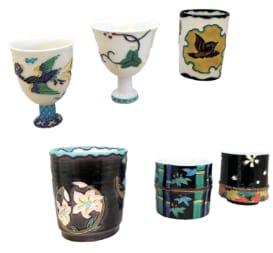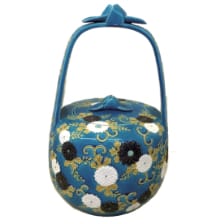A bit of knowledge about pottery
The history of pottery is ancient, and Jomon ware – from approximately 12,000 years ago - is probably the oldest. It was followed by Yayoi ware, before, in the tumulus period of the 5th century, Sue ware (unglazed pottery fired at high temperatures) emerged. Then, by the Nara period, glazed wares were being produced, and regions began producing their own distinctive wares, leading to the establishment of six regional types of pottery referred to as rokkoyo, or six ancient kilns: Tokoname-yaki (Aichi prefecture), Seto-yaki (Aichi prefecture), Echizen-yaki (Fukui prefecture), Shigaraki-yaki (Shiga prefecture), Tamba-yaki (Hyogo prefecture) and Bizen-yaki (Okayama prefecture).

Earthenware and Porcelain
Pottery is regarded as something made of earth, or clay; whereas, porcelain is thought of as stoneware made of clay mixed with crushed materials, such as quartz and feldspar. Earthenware is fired between 800 and 1250°C and porcelain wares at 1200 to 1400°C.

History of Kyo-yaki
Even before the Heian capital was established in Kyoto, pottery was being made in the Tumulus period.
About the 16th century, potteries had gathered around the Awataguchi area to make wares known as Awata-yaki.And,the Azuchimomoyama period saw ceramic techniques enter Japan from the continent, with Chinese potters making three-color wares and Cochin wares in Kyoto.
By the arrival of the Edo period, the production of tea ceremony wares, such as bowls and tea jars, was flourishing. Indeed, regional potters, from locales such as Seto and Karatsu, were brought to Kyoto to produce wares, and the techniques for those regional wares were adopted and expanded upon in Kyoto. It was around this time that wares started to be produced by local pottery entities, including Kiyomizu-yaki along with Omuro-yaki, Mizorogaike-yaki and Shugakuin-yaki.
Nonomura Ninsei led the way with painted earthenware that established the first success of Omuro-yaki. Followed by Ogata Kenzan, who, along with his older artist brother Ogata Kourin, produced innovatively daring wares known as Kenzan-yaki. And, the House of Enraku, one of the senke jisshoku (ten craftsmen of the House of Sen [Senke]), was well known as a brazier maker and pottery.
Back in the latter half of the 16th century, Raku-yaki is said to have started when the tilemaker Chojiro used clay dug up during the construction of Hideyoshi’s Jurakudai villa to fire ware that became known as “Juraku-yaki”, noted for its low firing temperature (750-1100°C) and simplicity of design by hand and profile. An admirer of this ware, the warlord Hideyoshi, presented the potters with a seal engraved with the character “Raku” from his villa’s name, and Raku-yaki potters continues their craft to this day.
Porcelain wares entered Japan from the mainland long ago, but the first potter to make such wares in Kyoto was Okuda Eisen, back in the Edo period. His apprentices, Aoki Mokubei and Ninami Dohachi, also worked in porcelain.

What is Kyo-yaki?
Nowadays, the collective name for the pottery of Kyoto is “Kyo-yaki”, and traditional craft wares are referred to as “Kyo-yaki” or “Kiyomizu-yaki”. As an ancient capital of Japan, Kyoto was a magnet for arts and crafts of all regions, including earthenware and porcelain, painted earthen vessels and gold coated wares. Then, with the Momoyama period, came the Japanese tea ceremony, drawing even more potteries to Kyoto and spurring on artisans to make the skillfully refined but unique works truly associated with the city. With all these individually fantastic wares, Kyo-yaki still attracts many fans today.

Photo: ceramic ware (Kiyomizu-yaki-no-Sato)